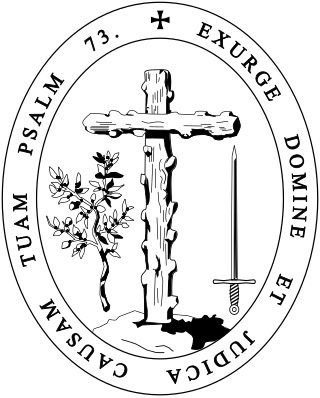
Grand Inquisitor was the lead official of the Inquisition. The title usually refers to the chief inquisitor of the Spanish Inquisition, even after the reunification of the inquisitions. Secretaries-general of the Roman Inquisition were often styled as Grand Inquisitor but the role and functions were different.

Braga is a city and a municipality, capital of the northwestern Portuguese district of Braga and of the historical and cultural Minho Province. Braga Municipality had a resident population of 193,333 inhabitants, representing the seventh largest municipality in Portugal by population. Its area is 183.40 km2. Its agglomerated urban area extends to the Cávado River and is the third most populated urban area in Portugal, behind Lisbon and Porto Metropolitan Areas.

The Metropolitan Patriarchate of Lisbon is a Latin Church ecclesiastical territory or patriarchal archdiocese of the Catholic Church in Lisbon, the capital of Portugal.
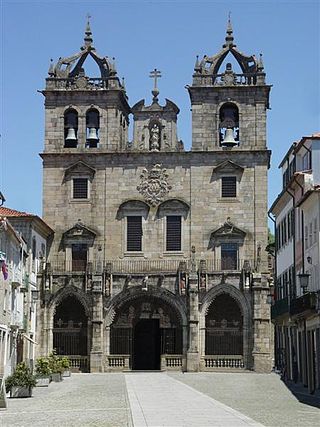
The Archdiocese of Braga is a Latin Church ecclesiastical territory or archdiocese of the Catholic Church in Portugal. It is known for its use of the Rite of Braga, a use of the liturgy distinct from the Roman Rite and other Latin liturgical rites.

The Diocese of Coimbra is a Latin Church diocese of the Catholic Church in Coimbra, Portugal. It is a suffragan of the Archdiocese of Braga.

Olivais is a freguesia and district of Lisbon, the capital of Portugal. Located in eastern Lisbon, Olivais is west of Parque das Nações, north of Marvila and Alvalade, and east of Lumiar and Santa Clara. The population in 2021 was 32,179.

José Rodrigues de Carvalho was a Portuguese painter.
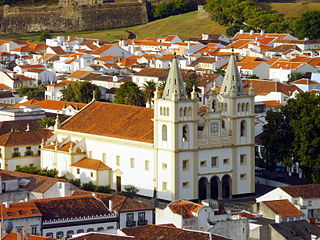
The Diocese of Angra is a Latin Church diocese of the Catholic church in the Portuguese archipelago of the Azores. The see is located in Angra do Heroísmo, in the Terceira island. The current Ordinary is Armando Esteves Domingues.

The Archdiocese of Évora is a Latin Church diocese of the Catholic Church in Portugal with Évora Cathedral as its see. It has as suffragans the diocese of Beja and diocese of Faro. The current archbishop of Évora is José Francisco Sanches Alves.
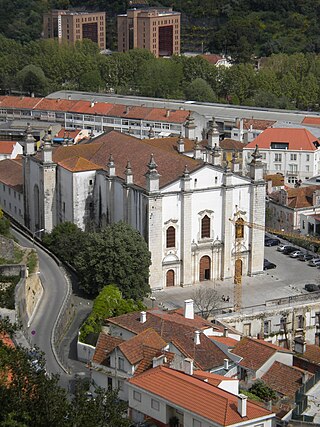
The Diocese of Leiria–Fátima is a Latin Church diocese of the Catholic church in Portugal. It is suffragan diocese in the ecclesiastical province of the Metropolitan Patriarchate of Lisbon.

The Diocese of Viseu is a Latin Church diocese of the Catholic church in Portugal. It is a suffragan of the archdiocese of Braga. Its see at Viseu is in the Centro Region. The current bishop is António Luciano dos Santos Costa.

The Diocese of Guarda is a Latin Church diocese of the Catholic church in central eastern Portugal, a suffragan in the Ecclesiastical province of the Latin Patriarchate of Lisbon in southern Portugal.
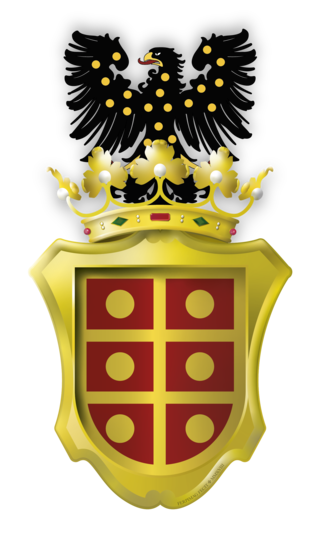
Marquess of Lavradio is a Portuguese title of nobility created by Letters Patent of King José I of Portugal on 18 October 1753 for D. António de Almeida Soares de Portugal, 1st Count of Lavradio and 4th Count of Avintes.
Miguel António de Sousa Horta Almeida e Vasconcelos, 2nd Baron of Santa Comba Dão was a Portuguese nobleman.
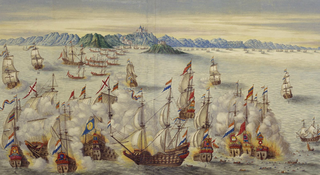
The Battle of Goa refers to a series of naval engagements between the Portuguese Armada and the Dutch East India Company fleets attempting to blockade and conquer the city of Goa. In 1638, forces commanded by the Viceroy of Portuguese India, D. Pedro da Silva and later António Teles de Meneses, fought off a large Dutch fleet sent to block the port colony of Goa, commanded by Admiral Adam Westerwolt, who was badly defeated at this encounter. The next year 1639, the Dutch Admiral Cornelis Simonsz van der Veere would conduct a new raid on Goa's port.

The Forty Conspirators, were a Portuguese nationalist group during the Iberian Union. The Conspirators were composed of forty men of the Portuguese nobility, and many clergy and soldiers. Their goal was to depose the House of Habsburg king, Philip III.

Santa Clara is a freguesia and district of Lisbon, the capital of Portugal. Located in northern Lisbon, Santa Clara is north of Lumiar, west of Olivais, and directly south of Lisbon's border with Odivelas and Loures. The population in 2021 was 23,645.

D. John Manuel of Athanagilds, 9th Count of Arganil was a Portuguese prelate, Archbishop of Lisbon and Viceroy of Portugal.

D. João de Sousa was a Portuguese prelate, Bishop of Porto, Archbishop of Braga and Archbishop of Lisbon.


















